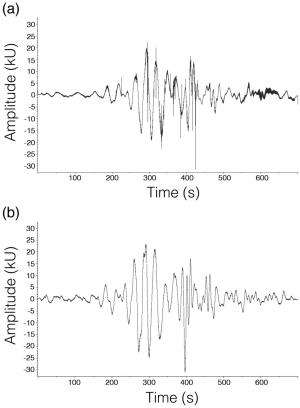(a) Waveform of a vibration generated by an adult male shuddering in a female's web, and (b) waveform of the same shudder in (a) played through an electromagnetic shaker. Credit: Scientific Reports 3, Article number: 3557 doi:10.1038/srep03557
(Phys.org) —Stated in scholarly terms, a newly published study says research results suggest that "male web-building spiders employ a phylogenetically conserved vibratory signal to ameliorate the risk of pre-copulatory cannibalism." Translation: A smaller and weaker male spider needs to rock the web so that the female spider won't kill him before mating.
The research was published Thursday in the journal Scientific Reports, by Anne Wignall and Marie Herberstein of Macquarie University in Australia. The paper is titled, "Male courtship vibrations delay predatory behaviour in female spiders." Specifically, male Argiope spiders produce a "courtship" shudder-like vibration in the web, which seems to lessen their chances of being eaten, but the authors also point out that the action merely may buy some time to cause the larger female just to delay her predatory behavior. The shudder delays female aggression and risk of attack, they said, during the earliest and potentially riskiest stages of courtship. The vibration is interesting in that it solves a major problem for male web-building spiders, as they attempt to court female spiders without being mistaken for prey.
The authors discussed their method: "We recorded the courtship shudders of five males in a web using laser vibrometry. To ensure that male courtship shudders would be accurately reproduced in our assays, we compared the vibrations from the original recording, and a recording from the electromagnetic shaker used to artificially generate the stimuli in the experiment. The vibrations matched well between the two sources."
Both authors have an interest in spiders as important models in evolutionary and behavioral research. Wignall, on her web site, noted her interest in understand more about spider courtship:
"Male web-building spiders go through an elaborate courtship routine on the female's web. While lots is understood about what happens after copulation in web-building spiders, there's very little information yet about what is actually being communicated by the male during courtship, or how courtship has been shaped by the unique ecology of web-building spiders."
Similarly, Herberstein on her site noted spiders as important models in research. "For a long time spiders have been underestimated as intriguing and suitable models for a variety of evolutionary questions."
More information: Male courtship vibrations delay predatory behaviour in female spiders, Scientific Reports 3, Article number: 3557 DOI: 10.1038/srep03557
sites.google.com/site/behaviou … /marie-e-herberstein
sites.google.com/site/aewignall/media
Journal information: Scientific Reports
© 2013 Phys.org























